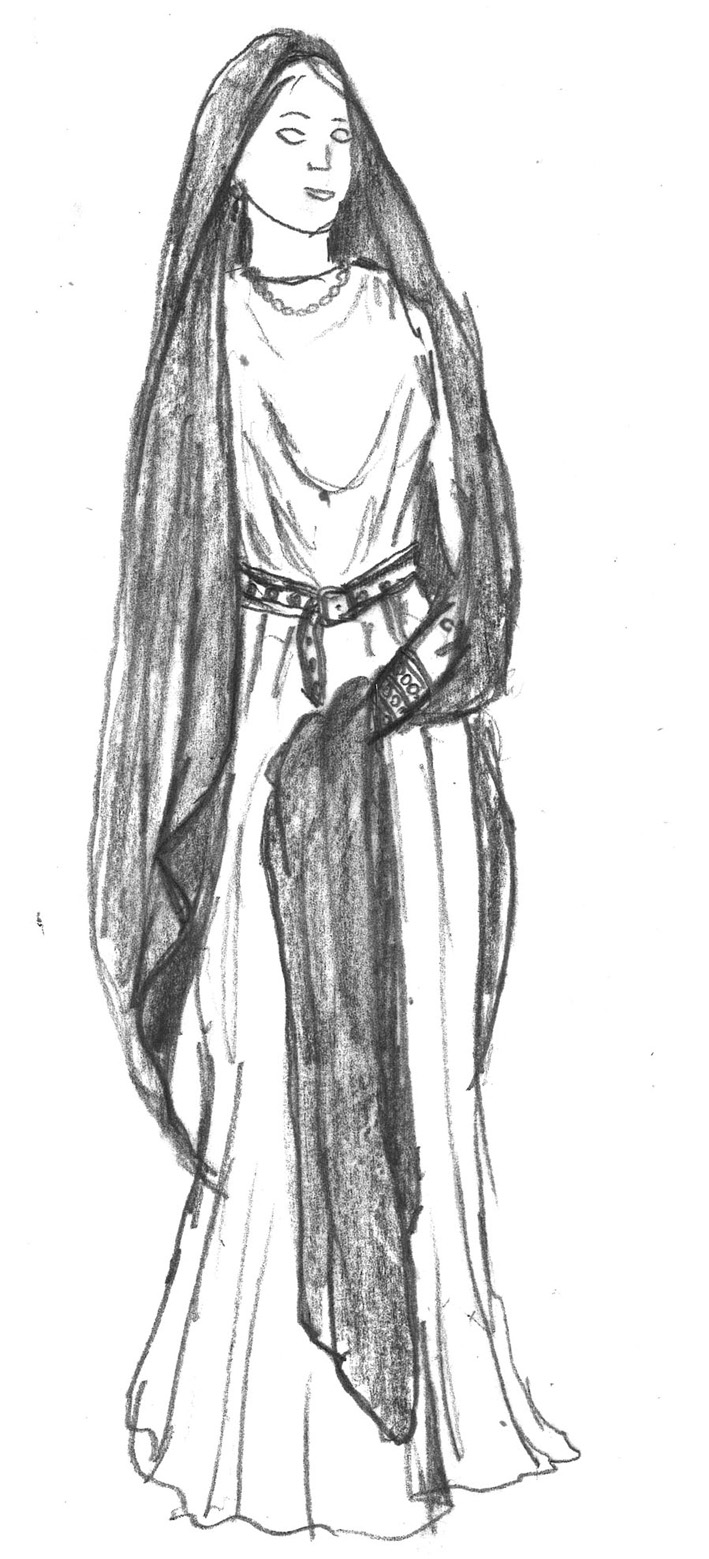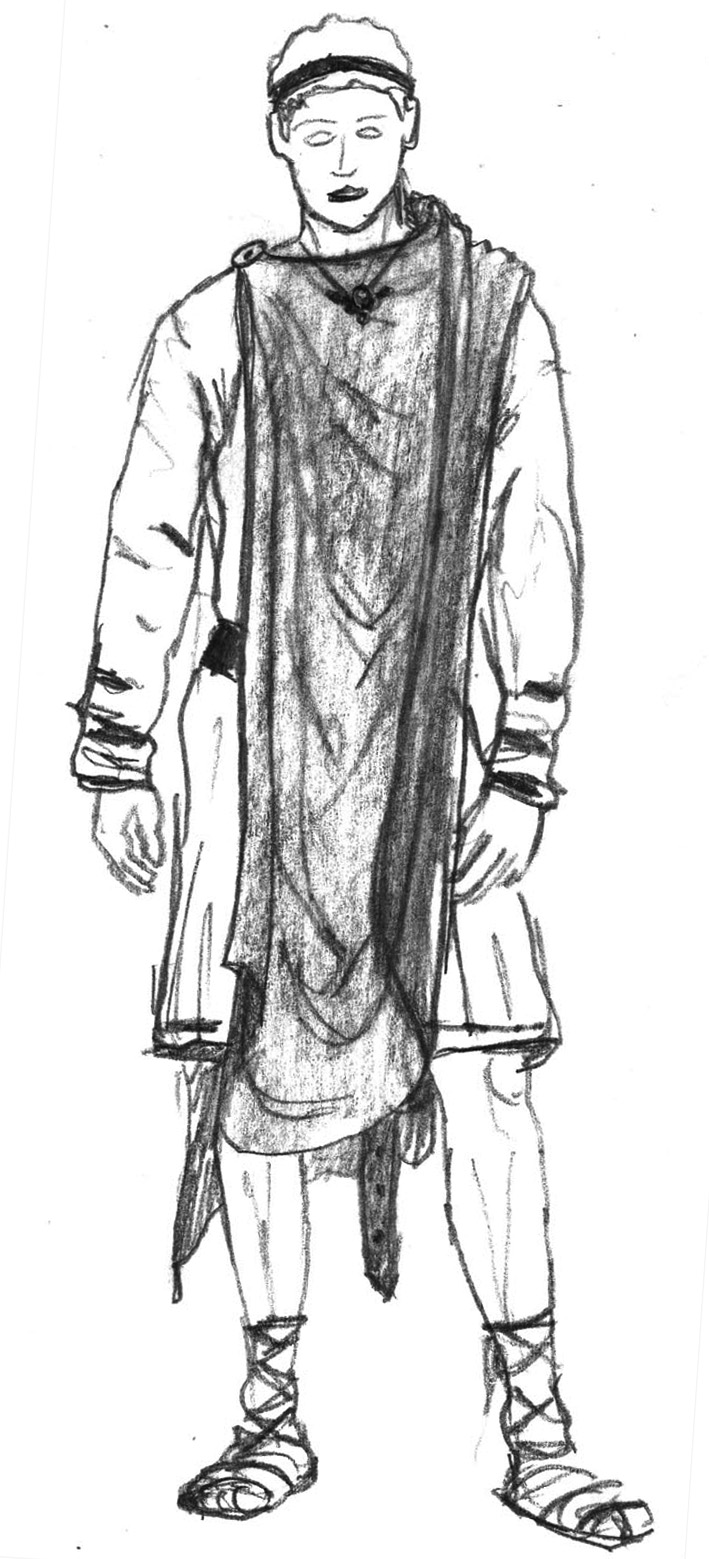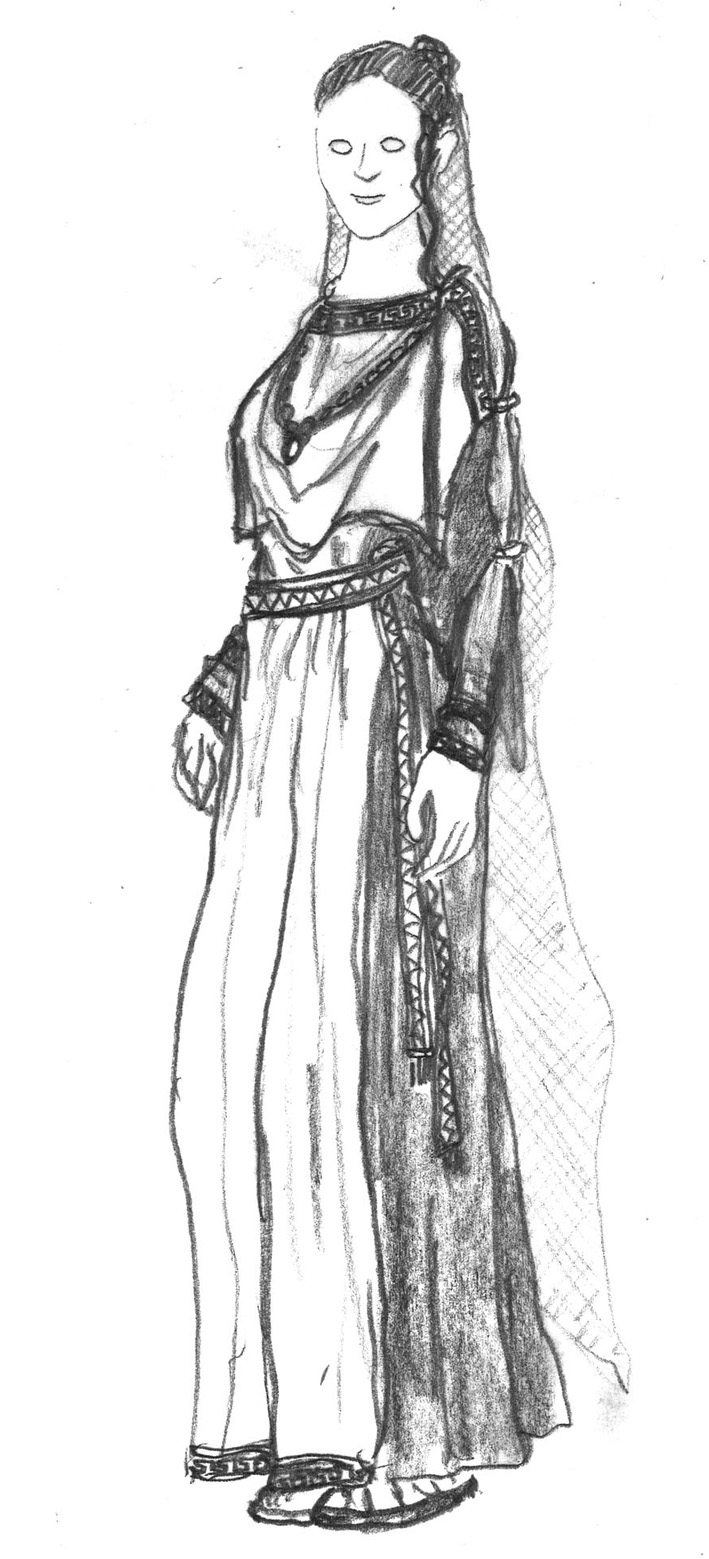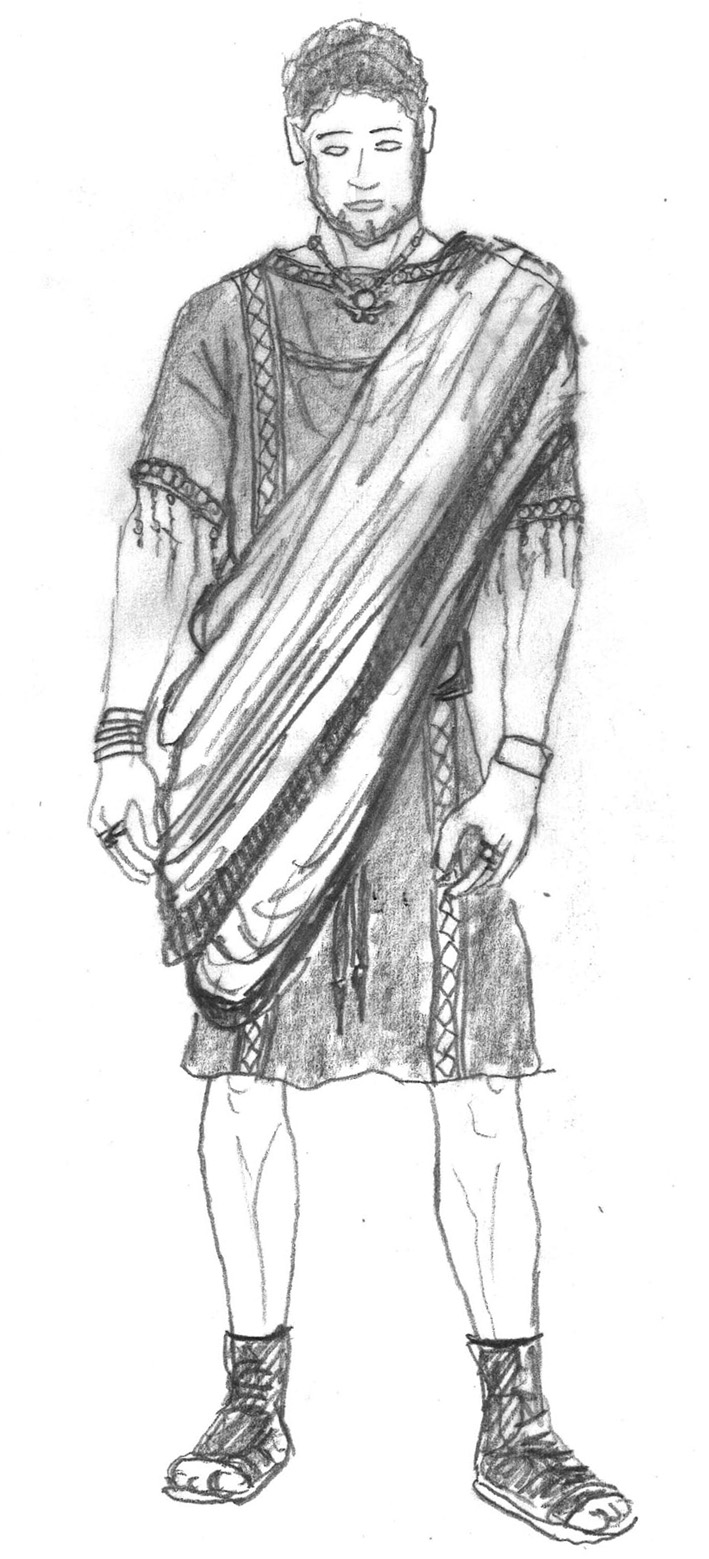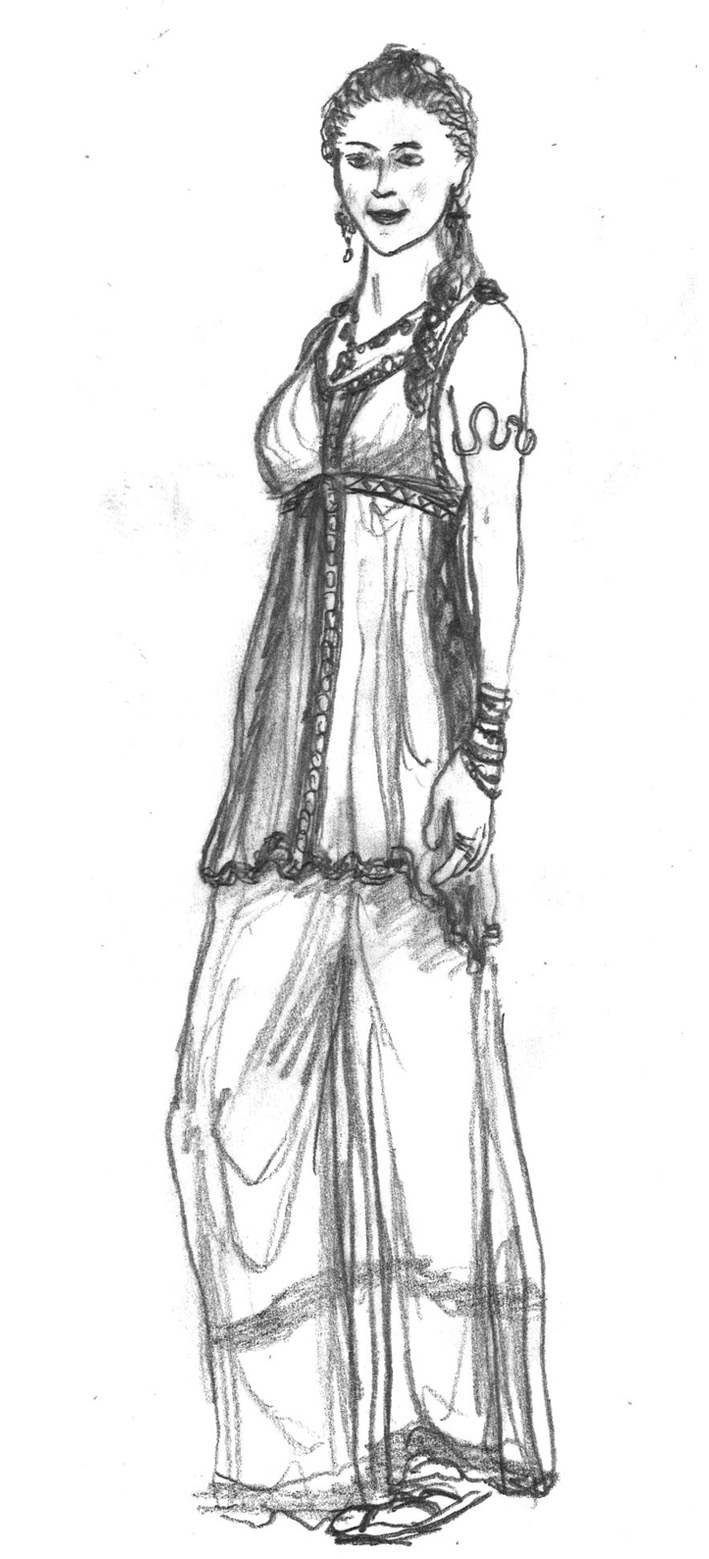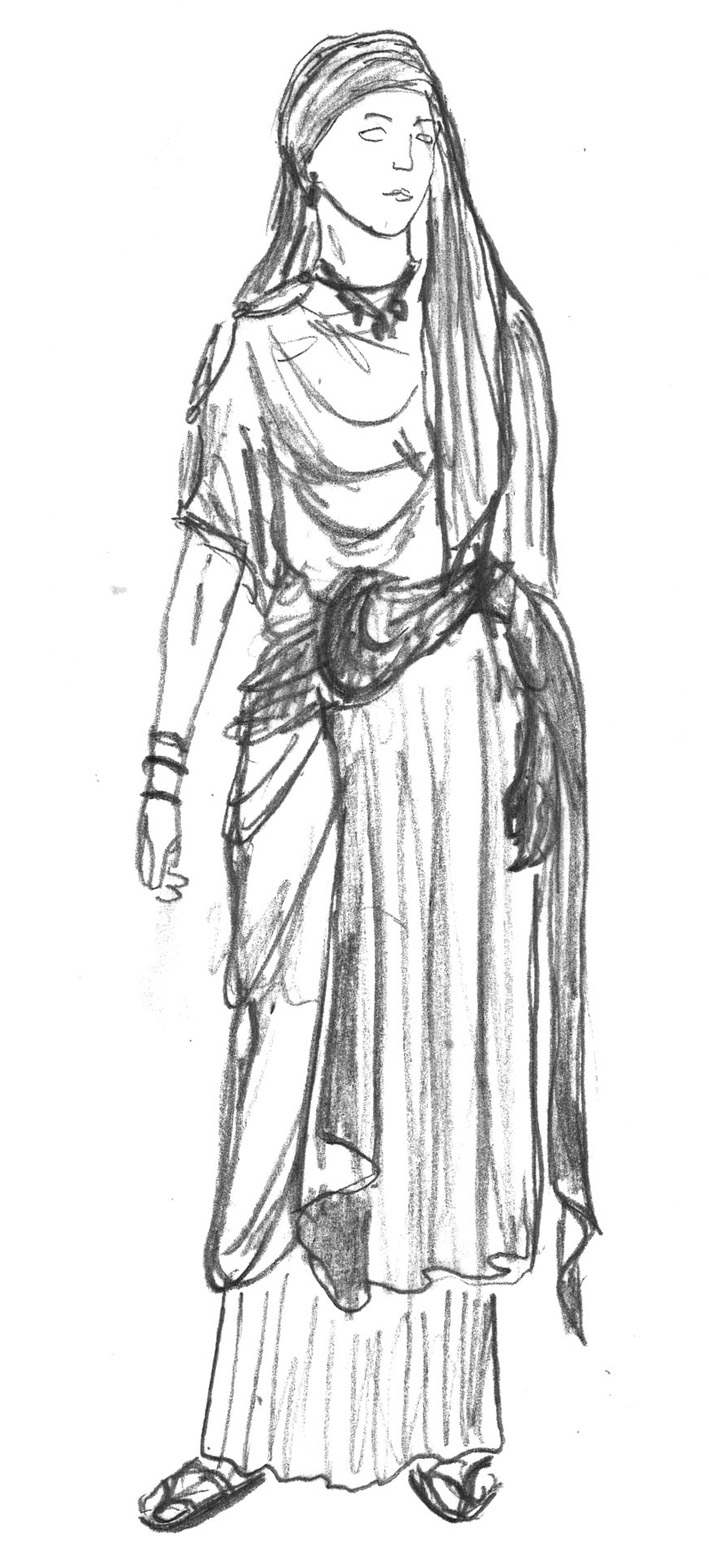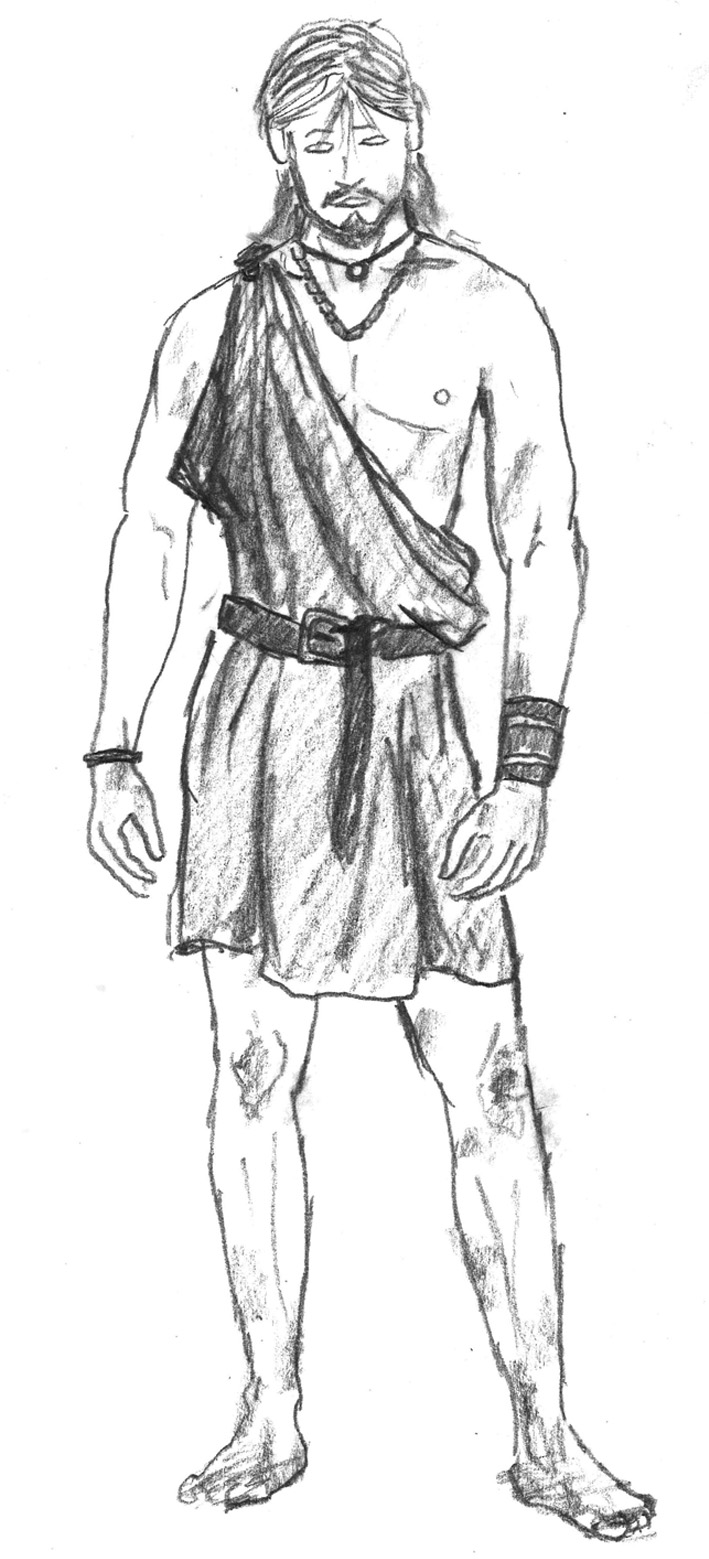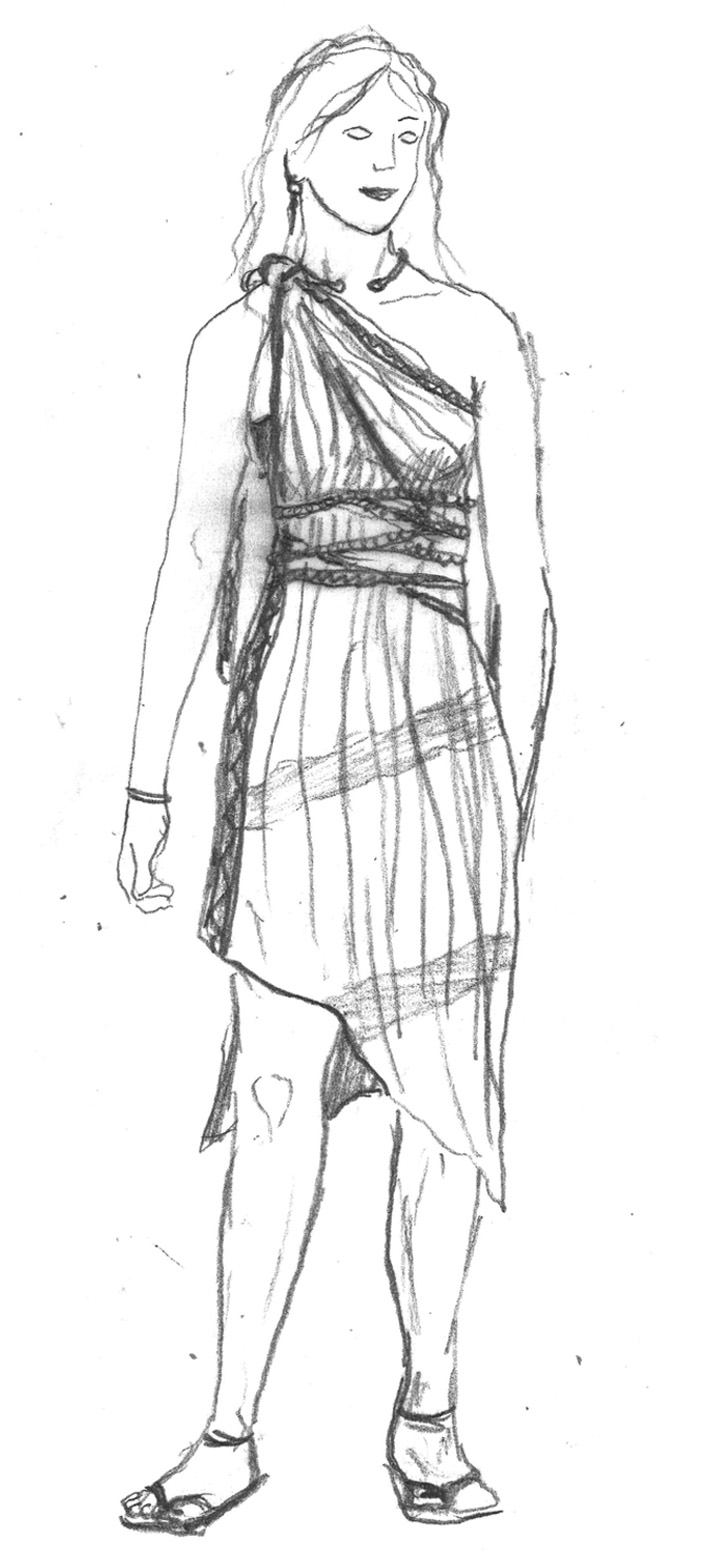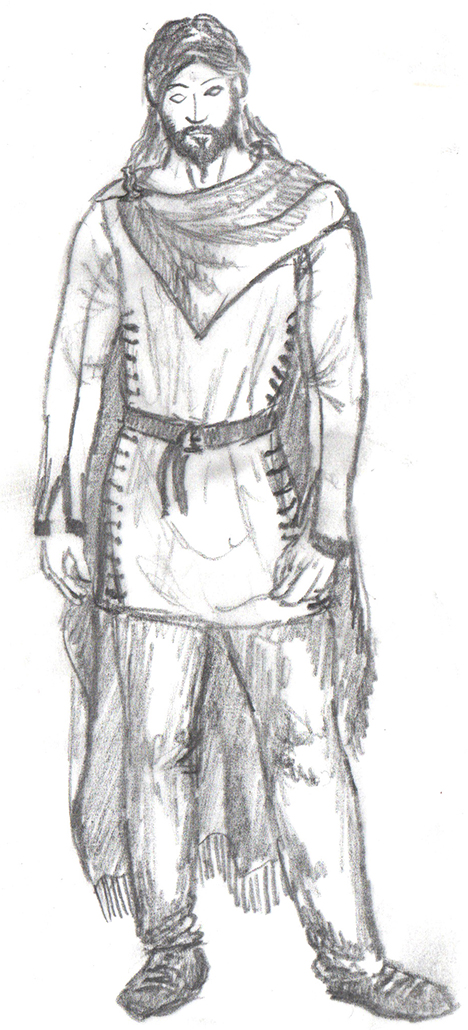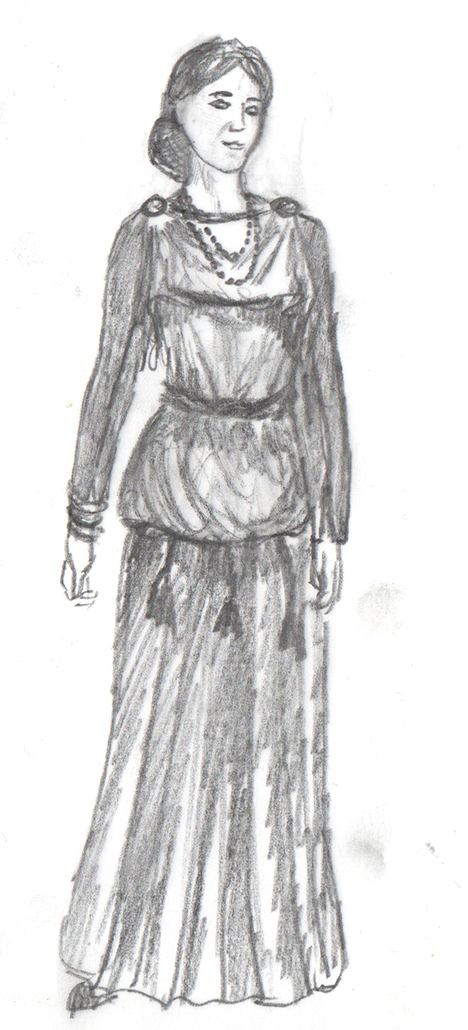Roman
„Two sheets and two fibulas, it has never been that easy!“
Roman clothes are generally wide and flowing – form-fitting cuts will not become commonplace until the medieval period. Many of the most common patterns are surprisingly simple, and frequently merely rely on the proper draping of the fabrics. Consequently it is perhaps more important to use appropriate fabrics, galloons and embroidery than in other settings. It is not necessarily required to hem the seams, as frayed edges and galloons may even add to the charm of a garment.
Romans frequently wear colourful clothes, as colours are an indication of wealth and good taste. Poor citizens and slaves will therefore usually have to resort to undyed, or darker coloured clothes. Some colours carry specific connotations:
- Only high-ranking magistrates and priests wear white, as it is too expensive and difficult to produce to be used in everyday life.
- Black fabrics are exceptionally rare. Even Romans who are in mourning might tend to wear dark fabrics, but not black.
- Purple is the most expensive available dye. To be able to wear even just a strip of purple edging on one’s clothing is a symbol of power and authority.
If you’re looking for examples or inspiration, here are some photographs of the games Scarbantia and Soronia Nova (by Hubert and Anna-Lucia).
This citizen wears a long tunic without sleeves, girded around the waist. She covers her body and head with a fashionable palla. Her attire is completed by bracelets and a necklace.
The citizens wears a long-sleeved, girded tunic with galloons along the seams and along the neckline. On his shoulders rests a light paludamentum, leaving his right side (sword-arm) open. Around his head he wears a narrow ribbon.
The Tunic
THE standard-garment for men (at knee-length) and women (at ankle-length) alike is the tunic, which is essentially a long shirt. It may feature sleeves of varying lengths.
To fabricate a tunic one needs fabrics, preferably wool or linen, and then a simple t-shaped cut will do the trick. The torso piece should be really wide, therefor the seam connecting the torso-piece and the sleeves can be located somewhere at height of the upper arm. Galloons along the seams, around the neckline as well as clavi (woven galloons running from the shoulders to the waist in two lines on the front of the tunic) complete the garment.
For rich Romans there are no limitations when it comes to colors, as they are a sign of taste and wealth. Poor Romans and slaves will wear earthy and cheaper colors, ranging from natural whites to beiges and browns.
The tunic is girded around the waist to give it shape. Women may wear additional ribbons around the breast to further accentuate their bodies. Working people, travellers and soldiers often pull the tunic higher up above the belt to free their legs for easier movement.
The Chiton
A garment worn mostly by poor and hard-working individuals. Men wear them with the lower seam on their thighs, a woman’s chiton reaches down to her ankles.
The chiton is nothing more than a rectangle of fabric which is folded around the left side of the body, covering the front and rear but staying open at the right side. The upper edge is held together by two fibulae or brooches located above the wearer’s shoulders, and the cloth girded around the waist.
An alternative way of wearing the chiton is to only use one fibula to pin the fabric together over the right shoulder, thus leaving the left side of the breast exposed. Women who wish to wear this style may chose to use additional wrappings to cover themselves.
Another (more complicated) option would be to sew-shut the right side of the chiton as well. After slipping into this tube one folds the fabric in a way that leaves the front broader than the back-part (by about 12cm/4.7 inches). Then one should gather the fabric slightly on both shoulders before sewing or pinning it in place, thus creating a natural v-neck. The lower edge of the back of this chiton, worn by men, should be cut round to ensure everything remains covered when the wearer attempts to bend down. . This is not necessary on a chiton intended for women, as the garment is going to be long enough regardless.
The chiton can be made from wool or linen. When using linen, you should pick a softer fabric, as this is important if you are aiming to achieve some good-looking drapery. When searching for patterns you might find different recommendations when it comes to favoured cloth widths. In general more fabric results in a more beautiful drapery.
Chitons may be worn by both genders. It is usually the garment worn by slaves and low-class citizens who are doing hard and physical labour. However, even politicians wear them from time to time if they wish to appear down to earth and connected to the common people.
If you are interested in more Greek fashion, in Simon Kirner’s style guide (in German) you can find it.
This roman lady went for a lengthy and long-sleeved, decorated tunic. Tunic and stola are held together by buttons above the shoulders and along the arms. She wears a narrow belt around the waist, and a long veil is attached to her hair, which is tied into a knot on the back of her head.
This wealthy citizen settled for a decorated short-sleeved tunic with galloons. He wears necklaces and a phallic amulet around his neck. His simplified toga is draped on the right shoulder, hanging down only as far as to his hips.
Underwear
Be aware that chiton and tunic may not always cover your private areas. Those who mind might want to wear a subligaculum, the roman underpants. Breasts can be covered by wrapping them with ribbons. This allows you to wear setting-appropriate clothes, regardless of whether you want to take-off your tunic or your chiton in order to take part in sporting activities, for strenuous work or to visit the bathhouse. We would like to avoid showing off anyone’s out-of-game underwear.
Gladiators wear special underpants made from a t-shaped piece of cloth, belted above the navel. To simulate this look, one might also wear a short skirt and a flap on top of the subligaculum.
The Stola
A stola is a dress for wealthy women, worn above the tunic or the chiton. It is worn long with the lower seam often reaching the ground. It is usually girded beneath the breast, or around the waist.
Another possible way of wearing the stola, is to fold-over the upper fifth of the fabric, before fixating it above the shoulders with fibulae or buttons in a way that leaves the folded fabric to cover the breast a second time.
Here you can see a beautiful orange Stola under a pink cloak.
The Toga
The toga is the mark of a Roman citizen and is worn exclusively by free adult men. A toga is made of a long strip of wool, cut into a semicircle.
It is worn on the left shoulder and wraps around the hips. Rich Romans, however, tend to wear a less elaborate and annoying version that can simply be tucked into the belt.
The toga is very impractical and not suitable for running, fighting, or physical work, but the extensive drapery allows the wearer to comfortably store treats, wineskins or knifes.
This wealthy citizen settled for a decorated short-sleeved tunic with galloons. He wears necklaces and a phallic amulet around his neck. His simplified toga is draped on the right shoulder, hanging down only as far as to his hips.
This priestess wears a short tunic buttoned along the arms, above a longer one. The palla rests on her head and is draped around her waist, hiding her belt – a sign for great chastity. She even wears an additional headscarf under her palla, to cover her hair.
Die Cloaks
The sagum was originally part of the legionnaires uniform, but is also part of regular citizen’s attire by now. It’s made from a rectangular piece of woollen fabric, the upper third of which is folded over in a way that allows for the excess fabric to be used as additional protection for the shoulders or the head. It’s fixated with a fibula above the shoulder of the sword-arm.
The paenula is a hooded cloak, which is closed at the front by a single button or a fibula. It is highly weatherproof and is worn by both genders alike.
The palla is a long and roomy rectangular cloak worn by women. It can be draped over the shoulders, around the body or even around the head. Brooches and fibulae can be used to hold it in place.
The chlayms or paludamentum is a light summer-cloak for men, which resembles the sagum but is made of a considerably lighter cloth, and generally uses less fabric. It, too, originated in the military and is therefore not frequently worn by women.
Headdress
Craftspeople, fishermen and soldiers all can wear the pileus, a cap made from felt (or alternatively from wool or linen), which is worn on the crown of the head Legionnaires use it to pad their helmets. The pileus is cylindrical and brimless, and serves as a symbol for freedom, as slaves are not allowed to wear it. Hence it is rather popular among freed men and women.
Civilians, free people and slaves alike need to protect themselves from the sun. Therefore broad-brimmed straw hats are popular all throughout the Roman population.
Another popular and classic headdress is a simple narrow ribbon, worn just above the hairline.
Women may wear a veil tucked into their hairdo. Covering the head with a veil is a sign of great virtue.
Footwear
Roman citizens wear sandals (soleae), soldiers prefer the studded version (caligae), peasants’ boots or boots with high legs. The latter are also popular with wealthy civilians or aristocrats. Poor citizens and slaves often own no footwear at all.
One traditionally takes off the sandals while eating, leaving them to be looked after by slaves in the meantime.
Here is a simple step-by-step- guide to making your own “soleae”.
This slave has only fixated his chiton above one shoulder, leaving the left side of his chest exposed – the sign of a physical labourer. The long hair indicates that he might be of barbaric origin. Despite his low status, he still wears simple jewellery.
This slave wears a slightly finer chiton which is open on both sides. Her breasts are covered by ribbons, and her body is wrapped in pretty braids. She surely serves a wealthy family.
Trousers
Contrary to popular opinion, trousers were already part of the Roman attire. They came to the empire via the Celts and Germanic tribes, which is why they didn’t lose their reputation as somewhat barbaric for a long time. Regardless, they were already worn quite frequently beneath the tunics of legionaries. These roman trousers (feminalia) were knee-long, and were made from leather or linen.
Belts
Women and men alike belt their clothes around their waist (approximately at navel-height).
Belts are made from leather, and can be worn short with a buckle-plate at the end, or long with the end hanging down the thigh. A soldier’s belt might also be studded with rivets or plates.
Poor Romans often do not own belts, and instead gird their clothes with ropes, woven or tablet-woven ribbons, or cords.
Hairstyle
The hairdos of emperors and empresses, widespread by portraits on coins, are always in vogue.
Women wear their hair mostly in curls. Long hair is a sign of beauty, good health, wealth and youth.
Poor women wear their hair open or tied into a convenient knot, if their work requires it. Rich women, on the other hand, keep their slaves busy by letting them form their hair into curls, updos, or other elaborate styles. Wigs in exotic colours, such as blonde or red, are also very popular. Those are made from the hair of Germanic prisoners of war.
For men long hair is a sign of barbarism, and is therefore only seen on slaves – if they haven’t been shorn as a sign of suppliant status, or to sell their hair to wig-makers. However, since emperor Hadrian well-groomed beards are once more permissible.
It is fashionable to have one’s body hair removed in order to emulate a youthful bodily ideal.
Jewellery
Jewellery is an essential part of Roman fashion and men and women alike wear lots of it, assuming they have the money to do so.
Rings, necklaces, bracelets and hair-bands are worn by both genders, whereas earrings are only seen on women. Fancy rings in particular are a symbol of privilege among Roman citizens. During times of civil war it is also common to wear rings containing small capsules of poison, used for the quick and convenient suicide.
Even slaves might be able to afford simple jewellery, but most of them only wear a badge tied around their neck, which displays their owners name. A badge like this might say: CREON BASILII AUREIANI – Creon, (slave) of Basilius Aurelianus. Sometimes these texts also include other information, such as: NECA ME QUI FUGITUM VIDES – Kill me, as you are looking at a fugitive, or: FUGI REDDE ME BASILIO AURELIANO PRETIO ARGENTI – I’m a fugitive; Bring me back to Basilius Aurelianus and get silver for it.
This Germanic man wears long trousers under his corded smock. A rectangular cloak covers his shoulders, secured by a bow-fibula. He wears his hair open.
The Germanic woman wears a long-sleeved smock, accompanied by a long skirt. Her stola is folded-over on the top, and girded around the waist. Around her neck she wears necklaces made from amber, and her hair is covered by a net.
Clothes of the Germanic Tribes
When it comes to clothes, Germans and Romans very much look alike. Their fabrics are made from wool or linen, and garments tend to be held in place with fibulae and brooches.
The most widely used symbol is the eagle, as it is the most important symbol of the Goths. , When it comes to jewelry, amber is one of the most popular materials.
Men wear trousers (e.g. following the Thorsberg pattern). The most common outerwear is called a smock, and resembles a chiton which has been laced up at the sides. There are versions of the smock with and without sleeves. . Like the Roman sagum, the Germanian’s cloak tends to be rectangular and is closed above the shoulder of the sword-arm with a brooch.
Although a beard is regarded as a typical symbol of the barbarian, many Germanic men are clean-shaven. Young men (from the Quadi tribe) frequently wear their hair tied into a knot at the side of their head, according to Suebian fashion.
Women wear skirts which reach down to their ankles as underclothing. They are made from a simple fabric-tube, which is girded around the hips. On top they can either wear a smock, or a stola which resembles the roman model. Necklaces made of amber are a very popular type of jewelry. Women usually wear their long hair open, in a hairnet or under a veil.
Graphics from Wikipedia and Stefan Petrovič

